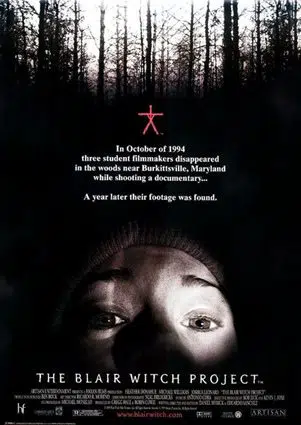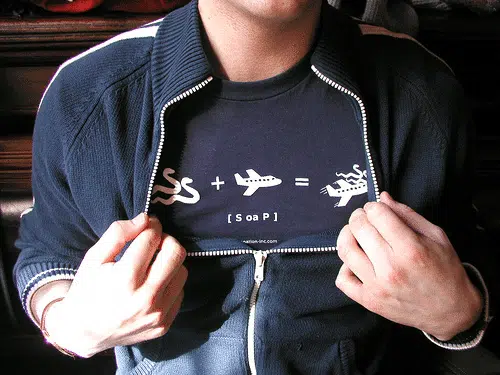Throughout the history of film, studios have continually had to figure out new ways to market their product as technology has evolved. Initially they were limited to print advertising, which is still a major promotional tool when it comes to one-sheet posters. Once studios took advantage of the butts they already had in movie theaters, movie trailers became a regular thing. At this point, thanks to the Internet, the release of a new trailer is an event that people actively await. With the advent of television, trailers could be cut up and shown during the commercials of people’s favorite programs. Finally, when the Internet changed the game in the 1990s, studios had the chance to be as innovative as ever. While movie posters, trailers and TV spots are all found online, as well as their original sources, social networking has let people become as essential to the marketing of a film as the marketers themselves. Below are three historical examples of films that generated huge buzz via social networking to become part of the cultural conversation.
The Blair Witch Project
The first film to truly capitalize on the Internet and the power it has was The Blair Witch Project in 1999. The horror film had a micro-budget ($22,500), was from an indie film studio (Artisan Entertainment, which is now defunct) and did not have any star power to generate buzz, yet somehow opened right in the middle of the summer to the tune of $1,512,054 from only 17 theaters. By the end of its run it had made over $140 million. It did this through an innovative viral marketing campaign that included an archaic website with history about the Blair Witch, the use of message boards, and newsgroups. By making people believe that the Blair Witch was a real thing and that the events of the film were true, seeing the film of three missing individuals became an event. Nowadays found footage films are released regularly, but none have captured the zeitgeist like The Blair Witch Project.

Snakes on a Plane
The next film on our list became a cautionary tale to movie studios that just because there is hype online, it does not guarantee success in actual movie theaters. When the Samuel L. Jackson film Snakes on a Plane was announced to moviegoers, bloggers, social media users, and film geeks online reacted with glee. The premise of the film is right in the title and it is as dumb as it sounds. Future fans of the film came up with their own lines, which mostly consisted of profanity-laced dialogue from the star and merchandise would be made to cement its status as a cult classic.

New Line Cinema thought they had a major hit on their hands and had reshoots done to give the fans what they wanted. They added lines to the film that fans created online and changed the rating from “PG-13” to “R” in order to accommodate these lines. The additional budget would not lead to much success in the long run though. While online hype was huge, the $33 million film ended with only $34 million in the summer of 2006 in America. Just because a film is surrounded by hype by the geek crowd before release, does not mean it will translate to the masses or even that the geek crowd who was hyping it up will all show up. Sometimes people just want to joke about a film that is just as ridiculous as it sounds.
The Dark Knight
Our third and final film is the one that had the most buzz pre-release and was by far the biggest post-release. That film is the 2008 classic, The Dark Knight. By the time casting was announced for the film in the summer of 2006, social media was already becoming a big deal. Facebook, Twitter, YouTube, and MySpace all existed, in addition to countless blogs, message boards, etc. If people had an opinion it could be heard. When Warner Bros. announced the casting of Australian actor, Heath Ledger, the outcry was loud and clear. People just did not want a pretty-boy actor with no geek cred to play the most famous villain in comic book history.
 OLYMPUS DIGITAL CAMERA
OLYMPUS DIGITAL CAMERA
By the time The Dark Knight was shooting in 2007, it was time to turn the tide in the film’s favor and generate some positive buzz from the franchise’s very vocal fans. Rather than just release the first photo of Ledger’s Joker out of the blue, Warner Bros. began a yearlong campaign to engage users until the film’s release in July 2008. In order for users to unlock the initial photo, they were forced to send in their email. Each email submission would then reveal more of the photo. Once the complete photo was revealed the tide had been turned. The majority of fan boys, who were initially against Ledger’s hiring, were now praising his look. It would only continue once actual footage of Ledger’s performance was released and then after his death in January 2008. By the time The Dark Knight hit theaters, buzz was at a fever pitch. The film ended up opening to $158 million (a record at the time) and left theaters with $533 million (the second highest of all time). The Dark Knight was a perfect storm consisting of casting the right actor in the right role, getting the geek crowd engaged at the highest level so they’d help promote the film before it even hit theaters, and then delivering a product at the highest level so the mainstream audiences were just as invested.
Get Fans in on the Conversation
In conclusion, for films in the 21st century to truly be successful they have to get fans in on the conversation. The worst thing a film can have is zero buzz, so studios must do whatever they can to get their fan base help generate it. The Blair Witch Project, Snakes on a Plane and The Dark Knight were just three examples of films that had varying degrees of success thanks to social networking. Are there any films that you saw in theaters solely due to your social network?